![]()
![]()
![]()
Use LEFT and RIGHT arrow keys to navigate between flashcards;
Use UP and DOWN arrow keys to flip the card;
H to show hint;
A reads text to speech;
17 Cards in this Set
- Front
- Back
|
Temnospondyl |
greek for "to cut" |
|
|
Pelycosaur |
mammal-like synapsid |
|
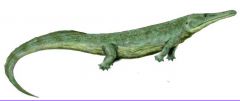
|
Prionosuchus
Temnospondyl amphibian
that probably hunted like a crocodile Largest amphibian ever at 30 feet long |
|

|
Diadectes
Reptilomorph
first amphibian herbivore
Reptile like skeleton & partial secondary palate, amphibian skull |
|
|
Reptilomorph |
Reptiliomorpha is a clade containing the amniotes tetrapods that share a more recent common ancestor with amniotes than with living amphibians. |
|
|
Labyrinthodont |
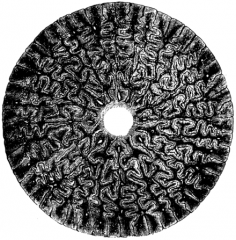
Labyrinthodont meaning "maze-toothed" describes the unfolding pattern of dentin and enamel in teeth |
|
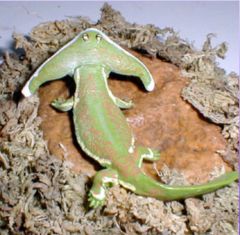
|
Diplocaulus
Lepospondyl amphibian with aboomerang-‐‐shapedhead• May have used itshead as a hydrofoil |
|
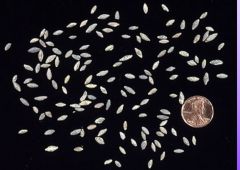
|
Fusulinids
single-celled organisms Tiny wheat‐like Foraminifera Over 5000 species in the Permian |
|
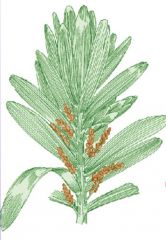
|
Cordaites Seed bearing gymnosperms Replaced the coal-swamp flora when the climate became drier |
|

|
Conifers Cone bearing gymnosperms Replaced the coal-swamp flora when the climate became drier |
|

|
Edaphosaurus first known Pelycosaur (mammal-like synapsid) to eat plants Small skull, uniform mandibular teeth & palate teeth |
|
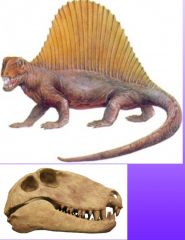
|
Dimetrodon Predatory Pelycosaur Mammalian traits include differentiated teeth and thermo-‐‐regulation using sail |
|

|
Moschops
Large, plant-eating dinocephalian therapsid
Thickened forehead bones may have been used in head butting contests |
|
|
dinocephalian |
clade of large-bodied early therapsids from middle Permian
thickened skulls with many knobs and bony projections. |
|

|
Inostrancevia Largest known gorgonopsid therapsid Predator that swallowed large chunks of meat |
|
|
gorgonopsid |
mammalian like therapsids
Mammal like characteristics include: differentiated (heterodont) tooth shape, a fully developed temporal fenestra, pillar-like rear legs, a vaulted palate that may have facilitated breathing while holding the prey, and incipiently developed ear bones |
|

|
Diictodon
Small dicynodont therapsid
Burrowing herbivore that lived in colonies |

